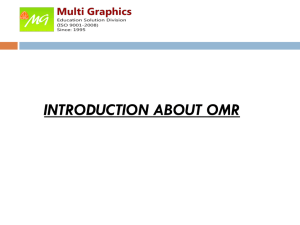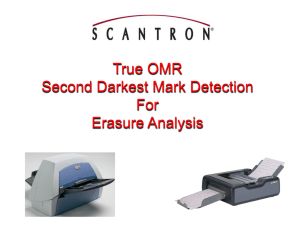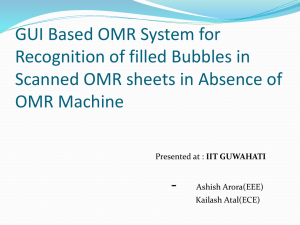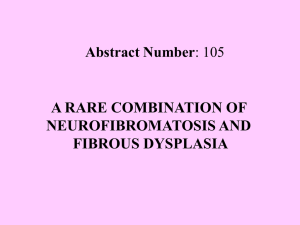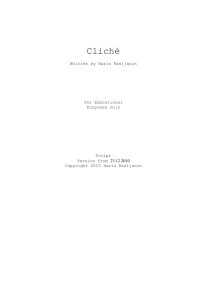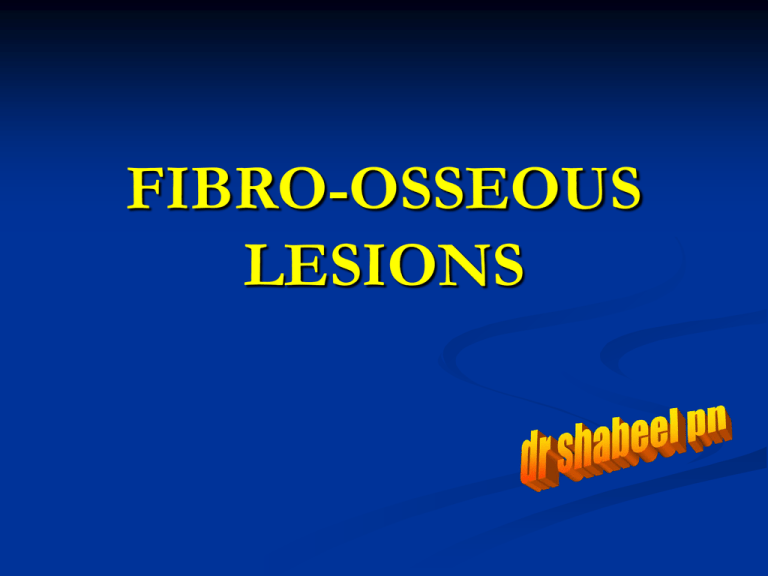
FIBRO-OSSEOUS
LESIONS
INTRODUCTION
The term ‘FOL’ is a generic designation of a group
of bone disorders characterized by the replacement
of bone by a benign connective tissue matrix that
displays varying degrees of mineralization in the
form of woven bone or cementum.
Group include:
developmental lesions
reactive / dysplastic lesions
neoplastic lesions
Dr.Haris PS/OMR
2
Importance of Specific Diagnosis
The histopathology of all FOL is identical,
although they range widely in clinical behavior.
More specific diagnosis is important because the
treatment of these pathoses varies from none to
surgical recontouring to complete removal.
Dr.Haris PS/OMR
3
CLASSIFICATION
FOL of medullary bone origin
FOL of PDL origin
FD
Fibroma
Fibro osteoma
CF
Cherubism
OF
Juvenile OF
COF
Giant cell tumor
ABC
Jaw lesions in hyperparathyroidism
Paget’s disease
Dr.Haris PS/OMR
4
WHO classification of Odontogenic tumors
(2nd ed, 1992)
(a) Fibrous dysplasia
(b) Cemento – ossifying fibroma
- Spectrum of COF: CF-COF-OF
- Juvenile Ossifying Fibroma
WHO type
Psammous type
(c) Cemento-osseous dysplasia
-PCOD
-Focal COD
-Florid COD
-Familial gigantiform cementoma.
Dr.Haris PS/OMR
5
Modified WHO classification
(Speight and Carlos)
Fibrous dysplasia
Monostotic
Polyostotic
Craniofacial
Osseous dysplasias
PCOD
Focal COD
Florid COD
Familial gigantiform cementoma
Ossifying fibromas
Conventional ossifying fibroma
Juvenile trabecular (WHO type) OF
Juvenile psammomatoid OF
Dr.Haris PS/OMR
6
FIBROUS DYSPLASIA
Developmental or hamartomatous condition
Unknown etiology
Characterized by proliferation of cellular fibrous
connective tissue mixed with bony trabeculae
Sporadic condition, resulting from post zygotic
mutation in GNAS– 1 gene
Clinical severity depends on the point of time
during embryonic, fetal or post natal life at which
mutation of GNAS – 1 occurs
Dr.Haris PS/OMR
7
Clinical Features
Monostotic fibrous dysplasia
Limited to single bone
80 – 85% of all cases
Jaws among most common sites
Diagnosed during second decade
No sex predilection
Painless swelling – most common feature.
Slow growth, become static with skeletal growth
completion
Dr.Haris PS/OMR
8
Craniofacial fibrous dysplasia
Peculiar form affecting skull bones
Not restricted to single bone, but confined to
single anatomic site.
Primarily affect maxillae, but may cross sutures
into sphenoid, zygoma, frontonasal bones and
base of skull.
Dr.Haris PS/OMR
9
Polyostotic FD
Involvement of two or more bones other than
craniofacial bones
Number of bones – a few to 75% of skeleton
With café au lait (coffee with milk) pigmentation,
Jaffe – Lichtenstein syndrome
With café au lait pigmentations and multiple
endocrinopathies – sexual precocity, pituitary
adenoma or hyperthyroidism, McCune – Albright
syndrome
Dr.Haris PS/OMR
10
May present with facial asymmetry
Clinical features usually dominated by symptoms
related to long bone lesions – Pathologic
fractures
Length discrepancy due to involvement of
upper portion of femur (hockey stick deformity)
Café au lait pigmentation – generally unilateral
tan macules on the trunk and thighs.
- May be congenital
- Oral cavity can be involved
- Margin typically irregular (Coastline of Maine)
Dr.Haris PS/OMR
11
Radiographic Features
Site – Most often involves maxilla
Posterior aspect. Unilateral
Periphery ill defined. Gradual blending
Internal structure.
Variation pronounced is maxilla
More uniform in mandible
Dr.Haris PS/OMR
12
Radiolucent
Mixed radiolucent-radiopaque
Heterogenous pattern
Orange peel – pathognomonic
Ground glass
Radiopaque – cottonwool or diffuse
Dr.Haris PS/OMR
13
Effect on surrounding structures
Thinning of cortex
Displacement of antral walls
Loss of lamina dura
Displacement of teeth
Interference with normal eruption
Inferior alveolar canal – displaced superiorly /
inferiorly
Superior displacement – unique to FD.
Dr.Haris PS/OMR
14
CT
To define extent of involvement of cranial base.
34 – 513 HU
Heterogeneous pattern of CT densities
associated with scattered or confluent islands of
bone formation
Dr.Haris PS/OMR
15
MRI
Intermediate signal on T1 weighted and proton
weighted images
Heterogenous hypointense signal of T2
weighted scan
Moderate to significant contrast enhancement
after i.v. Gd contrast infusion.
Dr.Haris PS/OMR
16
Management and Prognosis
Small lesions can be resected entirely
Most lesion stabilize with skeletal maturation
Surgical recontouring after skeletal maturation
Osteosarcoma-especially in those who received
radiation.
Dr.Haris PS/OMR
17



